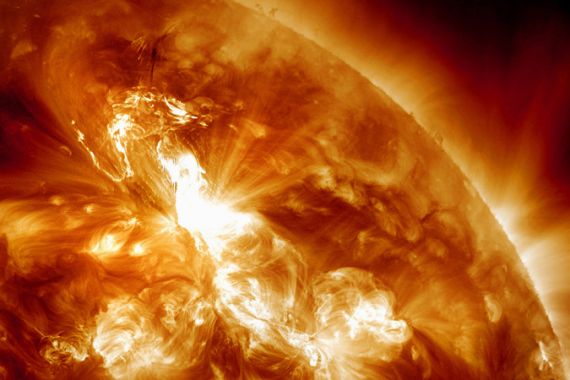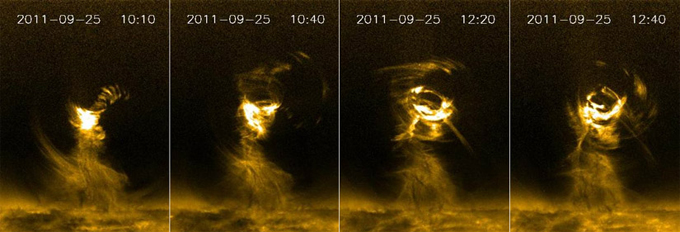Should we really worry about solar storms?
Although our technology is vulnerable to coronal mass ejections, technological advancement help to mitigate the effects.

Los Angeles, CA – Last month, the British government took the unprecedented step of declaring space weather one of the greatest threats to the country. Alongside terrorism, flooding and pandemics, we now have an extraterrestrial threat to add to the list of “things that could give you a really bad day”. But is Whitehall overreacting? And what is “space weather” anyway?
In Cabinet Office’s National Risk of Civil Emergencies report, it states: “Severe space weather can cause disruption to a range of technologies and infrastructure, including communications systems, electronic circuits and power grids.” Our planet is immersed in space weather continuously and it has one source: the Sun. Under the umbrella of space weather are solar flares, coronal mass ejections (CMEs) and the solar wind; all of which can impact the Earth’s atmosphere in varying degrees.
Keep reading
list of 4 itemsHong Kong’s first monkey virus case – what do we know about the B virus?
Why will low birthrate in Europe trigger ‘Staggering social change’?
The Max Planck Society must end its unconditional support for Israel
But space weather doesn’t pose a direct health threat to the citizens of the United Kingdom – so don’t worry about overdosing on solar radiation if you step outside (unless you’re an astronaut) or getting blowtorched by a “killer” solar flare. When we talk about the threat of space weather, we’re mainly concerned about modern society’s greatest Achilles Heel: technology.
| Solar storm, most powerful flares since 2005 |
As society becomes more dependent on the latest iPhones, powerful laptops, flashiest cars, comfortable air travel and complex power grids, we are unknowingly leaving ourselves more and more vulnerable to the effects of space weather and its impact to the Earth’s magnetic field.
Often, the most explosive solar events are bundled under the category “solar flares”, but this is only half the story. Alongside solar flares are another related, yet separate, solar phenomena: CMEs. Solar flares and CMEs may happen at the same time, and sometimes one may seem to trigger the other, but they are two very different beasts and each pose a challenge for the future of civilisation. A strong argument could even be made that CMEs have the potential to be more destructive than solar flares.
Solar mysteries
Although the Sun may be our nearest star, and solar physicists have a ringside seat of some fascinating stellar phenomena, many mysteries remain. For a start, one oddity that has foxed researchers for decades is the discovery that the Sun’s atmosphere is too hot. According to the laws of thermodynamics, the air surrounding a lightbulb cannot be hotter than the bulb itself. But for the Sun, this isn’t the case.
The solar corona is of the order of millions of Kelvin (or degrees Celsius), whereas the photosphere (colloquially known as the “solar surface”) is only 6,000 Kelvin. And therein lays the mystery: how is the Sun’s atmosphere so radically heated? Although evidence is mounting for the presence of powerful magnetohydronamic waves (specifically Alfven waves) propagating along magnetic field-lines from the solar interior to the corona, interacting with the plasma and heating it to astonishing temperatures, we won’t know for certain until we can send a probe deep into the corona. Plans are afoot to do just that, and NASA’s Solar Probe Plus is expected to be launched in 2018.
But why are we so interested in the corona? Well, the lower solar atmosphere is where flares and CMEs are spawned, so it would be nice if we can fully understand its mysteries – like the coronal heating phenomenon – so we may eventually arrive at more sophisticated means of predicting the onset of adverse space weather. The corona is one of the first links of the space weather chain that can ultimately influence our planet – if we master the corona, we can get a handle on space weather prediction.
Solar tornadoes
So, we may not have a direct means of measuring the conditions inside the corona (until 2018 at least), but we do have an increasingly sophisticated suite of solar sentries constantly watching the solar disk and sampling the solar wind – the constant stream of particles that bathe the entire Solar System. One such mission is NASA’s Solar Dynamics Observatory (SDO) that has been observing the Sun from Earth orbit since 2009. What makes this observatory different is its high-definition view of the Sun. Previously unseen small-scale features are being spotted and rapid coronal processes can now be tracked.
With the help of the SDO, a brand new magnetic feature was recently spotted ripping through the lower corona. On March 28, researchers from Aberystwyth University in Wales announced the discovery of a huge solar tornado – composed of twisting magnetic fields measuring up to five Earths across – dragging plasma from the lower corona to high altitudes, accelerating the material up to a blistering 300,000 kilometres per hour. Although this phenomenon may have been photographed in the past, it’s only with the help of the SDO’s rapid image acquisition technology that the researchers could watch the tornado evolve and identify it as such.
But how does this research fit with our quest to better predict space weather? “These tornadoes may help to produce favourable conditions for CMEs to occur,” said Xing Li, solar physicist at Aberystwyth and co-discoverer of the tornadoes. Whether or not this phenomenon triggers the eruption of CMEs remains to be seen – although, coincidentally, a tornado was spotted at the base of a CME prior to one eruption during the observations – but they are certainly another piece to add to the puzzle of the solar corona.
 |
| A solar tornado rages in the corona; could it trigger a coronal mass ejection (CME)? [NASA] |
When the sun attacks
Solar researchers and space weather experts are intently looking at every aspect of the Sun, from the internal dynamics of the solar body to the impact of the solar wind on our planet’s magnetosphere. But should the Sun hurl a massive CME toward us – a possibility that is becoming increasingly likely as the Sun picks up in activity toward the maximum in its 11-year cycle, peaking around 2013 – what’s the worst that could happen?
First off, it’s worth emphasising that life on Earth would not be directly impaired by such an event. So forget those sci-fi movies or crazy doomsday scenarios that would have you believe the planet will be burnt to a crisp in the wake of a solar flare. It’s actually the secondary effects of a solar storm that could cause some trouble. It is these effects that have gotten the UK government worried enough to issue a report on how scary solar storms can be.
Firstly, solar flares can unleash the energy of 100 billion atomic bombs. Fortunately for us, this rapid release of energy happens 150 million kilometres away (just above the Sun’s surface), but the Earth’s atmosphere does still feel the impact of flare events. Flares heat the upper atmosphere, causing it to expand, increasing drag on satellites in low-Earth orbit. Flares also mess with global radio communications as X-ray radiation is absorbed by the ionosphere.
Although flares can cause disruption (and potentially satellite losses), should the Earth receive a punch from an incoming CME, the ramifications can be far more acute. The problem is that CMEs are bubbles of plasma wrapped in a magnetic field. If the conditions are just right, this magnetic bubble can connect with the Earth’s global magnetic field (the magnetosphere) in such a way as to inject high energy particles (mainly protons) deep into the Earth’s atmosphere. Usually, the magnetosphere protects us from the constant radiation barrage from the solar wind, keeping the radiation at bay. But CMEs can penetrate our global magnetic shield, delivering huge quantities of charged particles to high latitudes of our planet. One of the most obvious signs that a geomagnetic storm is occurring is the eruption of bright aurorae. But it’s the invisible effects of a geomagnetic storm that have the potential to cause chaos.
As solar plasma rains through the atmosphere from the CME, powerful global electric currents are generated. This can cause unexpected surges in national power grids. This happened to Québec in 1989 when a CME slammed into Earth, inducing currents on the ground. The Hydro-Québec’s power grid was overloaded and knocked offline for nine hours.
But even this solar storm event is eclipsed by the “Carrington Event” of 1859. This was the largest solar storm in recorded history when the Sun blasted a very fast CME at Earth. It took hours to reach our planet. The induced electrical current was of epic proportions and the “internet” of the time, the telegraph, felt the full force of the geomagnetic storm. According to eyewitness accounts, telegraph operators were electrocuted and sparks flew from telegraph cables as they became overloaded.
Technology is our weakness and strength
We are currently observing some intense solar activity – the Sun has been popping off flares and CMEs with predicted fervour, behaviour that is expected to continue for several months. On January 25, the NOAA Space Weather Prediction Center even announced that the Earth was undergoing “the largest Solar Radiation Storm since October 2003 (The Halloween Storms)”, during a particularly intense solar storm.
There’s no way of knowing whether this solar cycle will generate a situation where another power grid gets knocked out. But if it did happen, the consequences could be dire. We live in a highly connected, energy hungry society. Should a national power grid become overloaded, it may just be knocked out for a few hours (like Québec in 1989), costing a power company a few million dollars in repair bills and lost revenue. But what would happen if a Carrington-sized CME hit us? We don’t know.
In a 2008 National Research Council report, it was estimated that should a Carrington-sized CME hit us, it could take us 10 years to recover and cost between $1 trillion and $2 trillion (in the first year alone) to repair the damage. But in a world where global financial markets are driven by our connected world, how can you put a price on the repair bill when currency no longer exists?
Fortunately, huge CMEs are rare and the technology that is leaving us so vulnerable to solar storms is helping us refine space weather prediction techniques. Let’s just hope we have plenty of warning before the next Carrington event overloads the planet.
Ian O’Neill is Space Science Producer for Discovery News. He is also the founder and editor of space blog Astroengine.
Follow him on Twitter: @astroengine
